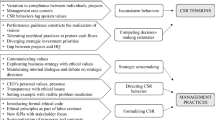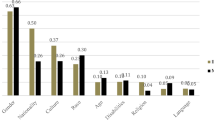Abstract
This study aims to fill part of a knowledge gap in the collaboration process and learn the practical ways to establish it. It is done by implementing a Soft Systems Methodology-based Action Research (SSM-based AR) to improve the collaborative working relationship among the four teams in one of the Big Four firms serving one global multinational client. This study learns the following: (1) Having similar objectives such as: serving the same client and providing better services for generating more revenues keeps motivating the four teams to continue collaborating. This learning informs the practitioners that clarifying the mutuality dimension is essential before starting the collaboration process. (2) SSM is the right methodology to study the collaboration process. Its basic assumption regarding conflicting worldviews in the social world provides a foundation to acknowledge and accept the conflict of self-interest versus collective interest, the agency dimension of the collaboration process. (3) The social capital (mutuality and norms) and agency dimensions play a more significant role than the structural (governance and administration) dimension in establishing the collaboration process in a professional services network firm (PSNF). (4) The practical steps to implement the five dimensions of the collaboration process should start by understanding the mutuality dimensions. (5) Embedding the theoretical framework in the root definition of SSM guides to address the dual imperatives of SSM-based AR.






Similar content being viewed by others
Data Availability
Not available due to confidentiality.
Code Availability
Not applicable.
Notes
Professional services network firms (PSNFs), the professional services firms (PSFs) with a network organization structure, are a business network of independent firms who come together to provide professional services to clients through an organized network cost-effectively.
References
Ansell C, Gash A (2007) Collaborative governance in theory and practice. J Public Adm Res Theor 18:543–571. https://doi.org/10.1093/jopart/mum032
Aunger JA, Millar R, Greenhalgh J et al (2021) Why do some inter-organisational collaborations in healthcare work when others do not? A realist review. Syst Rev 10:82. https://doi.org/10.1186/s13643-021-01630-8
Baker E, Kan M, Teo STT (2011) Developing a collaborative network organization: Leadership challenges at multiple levels. J Organ Chang Manag 24:853–875. https://doi.org/10.1108/09534811111175797
Bank AD (2007) Moving toward knowledge-based economies: asian experiences moving toward knowledge-based economies
Bardach E (1998) Getting Agencies to Work Together. Brookings Institution Press, Washington, D.C
Barringer BR, Harrison JS (2000) Walking a tightrope: creating value through interorganizational relationships. J Manag 26:367–403. https://doi.org/10.1177/014920630002600302
Baskerville RL (1997) Distinguishing action research from participative case studies. J Syst Inf Technol 1:24–43. https://doi.org/10.1108/13287269780000733
Bedwell WL, Wildman JL, DiazGranados D et al (2012) Collaboration at work: An integrative multilevel conceptualization. Hum Resour Manag Rev 22:128–145. https://doi.org/10.1016/j.hrmr.2011.11.007
Berg T, Pooley R (2013) Rich pictures: collaborative communication through icons. Syst Pract Action Res 26:361–376. https://doi.org/10.1007/s11213-012-9238-8
Blair MM, Kochan TA (2002) The new relationship: Human capital in the American corporation. Brookings Institution Press
Boussebaa M (2009) Struggling to organize across national borders: The case of global resource management in professional service firms. Hum Relat 62:829–850. https://doi.org/10.1177/0018726709104544
Brydon-Miller M, Greenwood D, Maguire P (2003) Why action research? Action research 1:9–28. https://doi.org/10.1177/14767503030011002
Bryson JM, Crosby BC, Stone MM (2015) Designing and implementing cross-sector collaborations: needed and challenging. Public Adm Rev 75:647–663. https://doi.org/10.1111/puar.12432
Bryson JM, Crosby BC, Stone MM (2006) The design and implementation of cross-sector collaborations: propositions from the literature. Public Adm Rev 66:44–55. https://doi.org/10.1111/j.1540-6210.2006.00665.x
Checkland P (1991a) From framework through experience to learning: the essential nature of action research. In: Nissen H, Klein HK, Hirschheim RA (eds) Information systems research: contemporary approaches and emergent traditions. North-Holland, Amsterdam, pp 397–403
Checkland P (1991b) In information systems research: contemporary approaches and emergent traditions. North-Holland, Amsterdam, pp 397–403
Checkland P (2000) Soft systems methodology: a thirty year retrospective. Syst Res Behav Sci 17:S11–S58. https://doi.org/10.1002/1099-1743(200011)17:1+<::AIDSRES374>3.0.CO;2-O
Checkland P, Holwell S (1998) Action research: its nature and validity. Syst Pract Action Res 11:9–21. https://doi.org/10.1023/A:1022908820784
Checkland P, Poulter J, Poluter J (2007) Learning for action: a short definitive account of soft systems methodology, and its use for practitioners, teachers and students. Wiley, Hoboken
Checkland P, Scholes J (1999) Soft systems methodology in action. Wiley, Hoboken
Cronholm S, Goldkuhl G (2003) Conceptualising participatory action research - three different practices. Electron J Bus Res Methods 2:47–58
Cropper S, Ebers M, Huxham C, Ring PS (2009) Introducing inter-organizational relations. The Oxford Handbook of Inter-Organizational Relations 1–22. https://doi.org/10.1093/oxfordhb/9780199282944.003.0001
D’Amour D, Ferrada-Videla M, San Martin Rodriguez L, Beaulieu MD (2005) The conceptual basis for interprofessional collaboration: Core concepts and theoretical frameworks. J Interprof Care 19:116–131. https://doi.org/10.1080/13561820500082529
Donaldson L (2001) Reflections on knowledge and knowledge intensive firms. Hum Relat 54:955–963. https://doi.org/10.1177/0018726701547008
Elden M, Chisholm RF, El-den M, Chisholm RF (1993) Emerging varieties of action research: introduction to the special issue. Hum Relat 46:121–142. https://doi.org/10.1177/001872679304600201
Emerson K, Gerlak AK (2014) Adaptation in collaborative governance regimes. Environ Manag 54:768–781. https://doi.org/10.1007/s00267-014-0334-7
Emerson K, Nabatchi T (2015a) Collaborative governance regimes. Georgetown University Press, Washington, D.C.
Emerson K, Nabatchi T (2015b) Evaluating the productivity of collaborative governance regimes: a performance matrix. Public Perform Manag Rev 38:717–747. https://doi.org/10.1080/15309576.2015.1031016
Emerson K, Nabatchi T, Balogh S (2011) An integrative framework for collaborative governance. J Public Adm Res Theor 22:1–29. https://doi.org/10.1093/jopart/mur011
Empson L, Muzio D, Broschak J et al (2015a) Teamwork and collaboration in professional service firms evolution, challenges, and opportunities. The Oxford Handbook of Professional Service Firms. Oxford University Press, Oxford
Empson L, Muzio D, Hinings C (2015b) Professional service firms: new developments and directions. Acad Manag Proc 2015:11240. https://doi.org/10.5465/AMBPP.2015.11240symposium
Gazley B (2017) The current state of interorganizational collaboration: lessons for human service research and management. Hum Serv Organ Manag Leadersh Gov 41:1–5. https://doi.org/10.1080/23303131.2015.1095582
Goldkuhl BG, Röstlinger A (2002) The practices of knowledge – investigating functions and sources
Gray B (1989) Collaborating: finding common ground for multiparty problems. Wiley, Hoboken
Gray B, Wood DJ (1991) Collaborative alliances: moving from practice to theory. J Appl Behav Sci 27:3–22. https://doi.org/10.1177/0021886391271001
Hermanto R, Putro US, Novani S, Kijima K (2021) Overcoming the challenge of those new with SSM in surfacing relevant worldviews for action to improve. J Oper Res Soc 1–16. https://doi.org/10.1080/01605682.2021.1970485
Huxham C (2003) Theorizing collaboration practice. Public Manag Rev 5:401–423. https://doi.org/10.1080/1471903032000146964
Huxham C (1996) Collaboration and collaborative advantage. Creatin. SAGE Publications Inc., Thousand Oaks
Huxham C, Vangen S (2005) Managing to collaborate: the theory and practice of collaborative advantage. Routledge, Abingdon
Jackson MC (2001) Critical systems thinking and practice. Eur J Oper Res 128:233–244. https://doi.org/10.1016/S0377-2217(00)00067-9
Koschmann MA, Kuhn TR, Pfarrer MD (2012) A communicative framework of value in cross-sector partnerships. Acad Manage Rev 37:332–354. https://doi.org/10.5465/amr.2010.0314
Løwendahl B (1997) Strategic management of professional service firms. Copenhagen Business School Press DK
Mckay J, Marshall P (2001) The dual imperatives of action research. Inf Technol People 14:46–59. https://doi.org/10.1108/09593840110384771
Mingers J (1984) Subjectivism and soft systems methodology - a critique. J Appl Syst Anal 11:85–103
Morley L, Mrt T, Cashell A, Mrt T (2017) Collaboration in health care. J Med Imaging Radiat Sci 48:207–216. https://doi.org/10.1016/j.jmir.2017.02.071
Nurunnabi M (2017) Transformation from an oil-based economy to a knowledge-based economy in Saudi Arabia: the direction of Saudi vision 2030. J Knowl Econ 8:536–564. https://doi.org/10.1007/s13132-017-0479-8
Ostrom E (1990) Governing the commons: the evolution of institutions for collective action. Cambridge University Press, Cambridge
O’Toole LJ (1997) Treating networks seriously: practical and research-based agendas in public administration. Public Adm Rev 57:45–52. https://doi.org/10.2307/976691
Pickering ME (2015) An exploratory study of organizational governance in publicly-quoted professional service firms. Organ Stud 36:779–807. https://doi.org/10.1177/0170840615571959
Powell WW (1990) Neither market nor hierarchy: network forms of organization. Res Organ Behav 12:295–336
Powell WW, Koput KW, Smith-doerr L (2012) Interorganizational and the collaboration locus of innovation: networks of learning in biotechnology. 41:116–145
Provan KG, Kenis P (2007) Modes of Network governance: structure, management, and effectiveness. J Public Adm Res Theor 18:229–252. https://doi.org/10.1093/jopart/mum015
Reynolds M, Holwell S (2020) Systems approaches to making change: a practical guide. Springer Nature, Berlin
Ring PS, van de Ven AH (1994) Developmental processes of cooperative interorganizational relationships. Acad Manag Rev 19:90–118. https://doi.org/10.5465/amr.1994.9410122009
Suryaatmaja K, Wibisono D, Ghazali A, Fitriati R (2020) Uncovering the failure of Agile framework implementation using SSM-based action research. Palgrave Commun 6:8. https://doi.org/10.1057/s41599-019-0384-9
Susman GI, Evered RD (1978) An assessment of the scientific merits of action research. Adm Sci Q 23:582. https://doi.org/10.2307/2392581
Teece D (2003) Expert talent and the design of (professional services) firms. Ind Corp Chang 12:895–916
Thomson AM, Perry JL (2006) Collaboration processes: inside the black box. Public Adm Rev 66:20–32
Thomson AM, Perry JL, Miller TK (2009) Conceptualizing and measuring collaboration. J Public Adm Res Theory 19:23–56. https://doi.org/10.1093/jopart/mum036
Vangen S, Huxham C (2003) Nurturing collaborative relations: building trust in interorganizational collaboration. J Appl Behav Sci 39:5–31. https://doi.org/10.1177/0021886303039001001
Ward KD, Varda DM, Epstein D, Lane B (2018) Institutional factors and processes in interagency collaboration: the case of FEMA corps. Am Rev Public Adm 48:852–871. https://doi.org/10.1177/0275074017745354
Wood DJ, Gray B (1991) Toward a comprehensive theory of collaboration. J Appl Behav Sci 27:139–162. https://doi.org/10.1177/0021886391272001
Acknowledgements
The authors also would like to express the deepest gratitude to School of Business and Management – Institut Teknologi Bandung (SBM-ITB), Jl Ganesha 10, Bandung, 40132, Indonesia, Faculty of Administration Science, Universitas Indonesia, M Building2nd Floor, Kampus UI, Depok, West Java, 16424, Indonesia.
Author information
Authors and Affiliations
Corresponding author
Ethics declarations
Conflict of Interest
The authors declare no competing interests.
Additional information
Publisher’s Note
Springer Nature remains neutral with regard to jurisdictional claims in published maps and institutional affiliations.
The Big Four firms refer to the four largest professional services network firms (PSNF), consisting of Deloitte, PricewaterhouseCoopers (PwC), KPMG, and Ernst & Young.
Rights and permissions
About this article
Cite this article
Budiarso, Putro, U., Sunitiyoso, Y. et al. Constructing the collaborative Working Relationships in one of the Big Four Firms. Syst Pract Action Res 35, 679–709 (2022). https://doi.org/10.1007/s11213-021-09588-3
Accepted:
Published:
Issue Date:
DOI: https://doi.org/10.1007/s11213-021-09588-3




